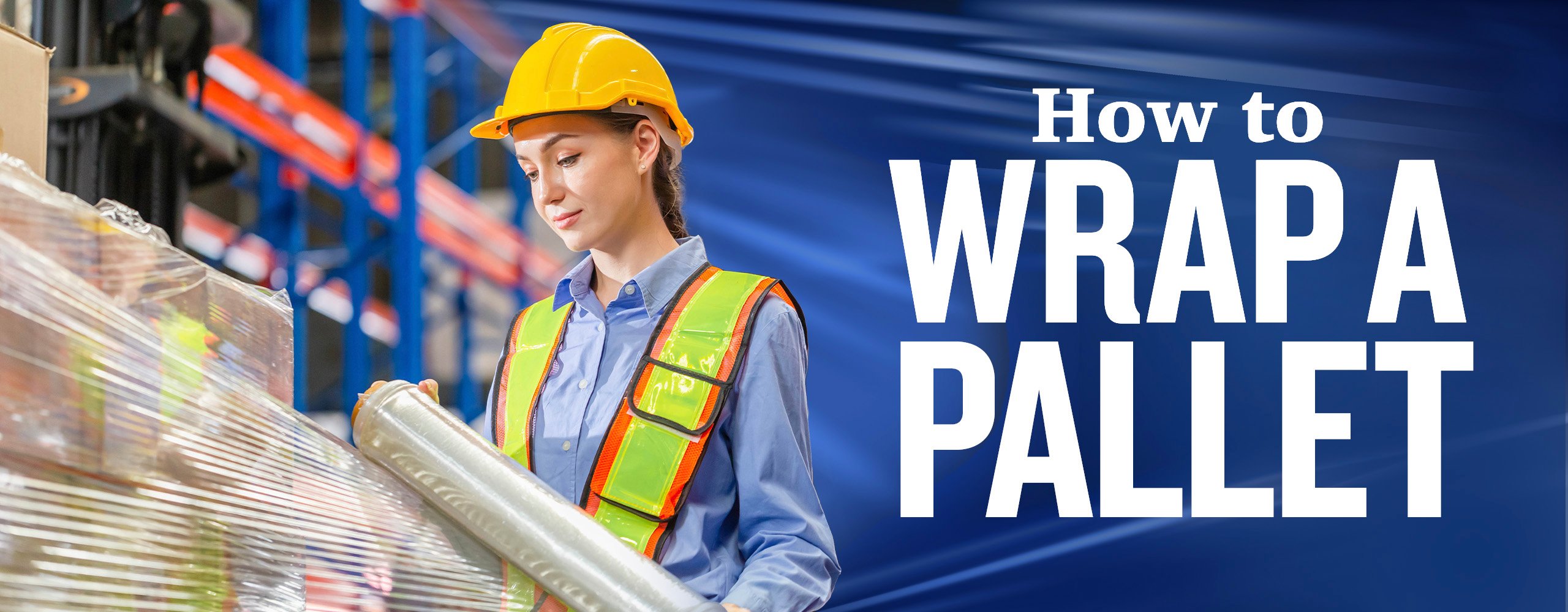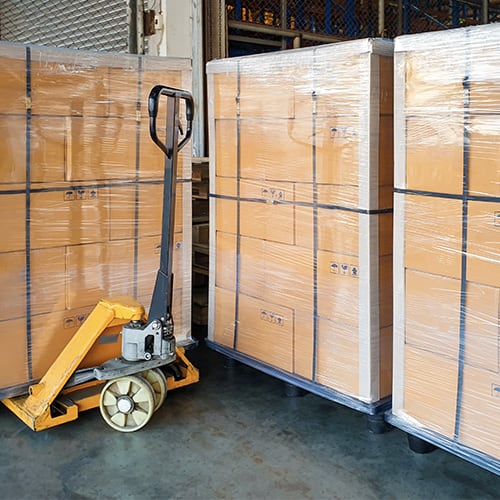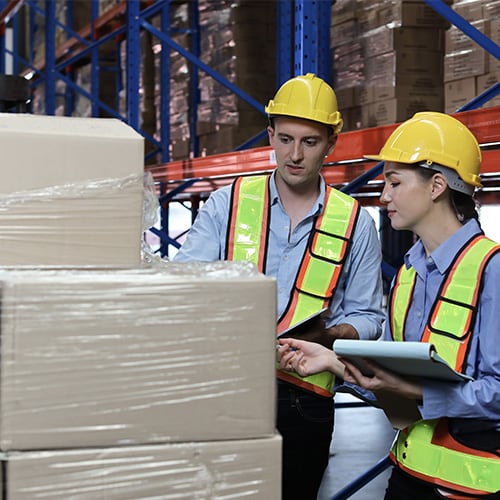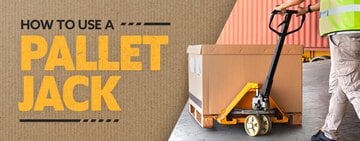
Pallet wrapping is an essential part of the warehousing process. It keeps goods secure, reduces the risk of lost inventory, and improves warehouse organization. Whether you own a warehouse or are just getting started in the industry, it's essential to familiarize yourself with pallet wrapping. We’ll walk you through how to wrap a pallet, investigate different types of pallet-wrapping equipment, and answer frequently asked questions about the topic.
Shop All Pallet WrapPallet Wrapping Video
Watch the video below for a comprehensive guide on how to wrap a pallet:
How to Wrap a Pallet

Though wrapping a pallet may seem simple, there are several details to keep in mind for the best results. To wrap a pallet the right way, follow these steps:
- Stack the pallet: Before wrapping, verify that your pallet is properly stacked. Inspect the structure of the pallet, stacking pattern, and weight of the boxes to keep them from falling as you wrap. Fasten the pallet with strapping bands to hold everything in place.
- Secure the wrap: Secure the stretch wrap before you begin wrapping to maintain tension and prevent anything from coming loose. You can secure the wrap by tying one end to the pallet's base or wedging the end of the wrap between two boxes.
- Secure the bottom: The base is integral to the structure of the pallet. If it is not secure, your wrap will not be effective. Secure the bottom of your pallet by starting at the pallet base, covering at least 1 inch in pallet wrap. For the best results, wrap around the bottom up to five times before advancing.
- Wrap upwards: Hold the wrap roughly 10 inches from your pallet and walk forward. If you are using stretch wrap, stretch the wrap about 30-50% around the corners of the stack to ensure complete coverage. Maintain tension as you wrap the pallet and aim for 50% overlap between layers to enhance the strength of your wrap.
- Wrap the top: Once you reach the top, stretch the film around the top corners of the pallet and pull slightly downwards. Secure about 1 inch of film over the top of your pallet corners to finish the wrap.
How to Shrink Wrap a Pallet
Shrink wrapping your pallets creates an air-tight seal, ensuring the pallet is secure and ready for shipping. By creating this seal, shrink wrap also provides an added layer of protection from environmental hazards. To shrink wrap a pallet, follow these steps:
- Stack and wrap the pallet: Using shrink wrap, follow the steps outlined above to wrap your pallet. Verify the entire pallet is wrapped and that there are no gaps in coverage.
- Heat the shrink wrap: Once the pallet has been wrapped, use a heat gun or shrink wrap gun to apply heat. This will shrink the wrap to the size of the pallet, creating a tight seal.
It’s important to note that you can also use heat-shrink bags to shrink wrap a pallet. While these bags are more convenient than shrink wrapping the pallet by hand, they may not fit the size of your pallet.
Pallet Wrapping Tools

The pallet wrapping process can be physically taxing, and various equipment and tools exist to assist your employees as they wrap. With these tools, you can create a more efficient process and allow your warehouse staff to focus on other tasks in the workplace. Some of the most common pallet-wrapping tools include the following:
Stretch Wrap Machines
A stretch wrap machine is a form of automated warehouse technology that wraps pallets on its own. They come in both automatic and semi-automatic varieties and allow you to reduce wrapping waste. There are three main types of stretch wrappers:
- Turntable stretch wrappers: These machines feature a spinning turntable that rotates the pallet to dispense stretch wrap. They are ideal for most commercial wrapping applications.
- Rotary arm stretch wrappers: This stretch wrap machine utilizes a mechanical arm to wrap pallets. They can be used for all types of pallets, but are particularly useful when working with light loads or heavy loads.
- Horizontal stretch wrappers: This machine utilizes a horizontal ring that surrounds pallets and wraps them. They are ideal for wrapping lengthy items that would otherwise be difficult to wrap such as doors, windows, and textiles.
Stretch Wrap Dispensers
A stretch wrap dispenser makes applying stretch film by hand easier. It gives the user enhanced control over the wrapping process, improving accuracy and ensuring the entire pallet is secure. We’ll introduce the four main types of stretch wrap dispensers below:
- Handheld stretch wrap dispensers: These dispensers give you increased mobility as you wrap your pallet. They feature small handles that can be placed on a roll of pallet wrap, allowing you to maintain tension. Some handheld stretch wrap dispensers feature an extended handle that enhances your reach.
- Adjustable stretch wrap dispensers: An adjustable stretch wrap dispenser offers superior control while wrapping pallets. These dispensers are easy to use and feature two conveniently placed handles that you can adjust to ensure optimal tension as you wrap.
- Stationary stretch wrap dispensers: A stationary stretch wrap dispenser can be placed on the floor or mounted on a wall. They are designed to hold large amounts of stretch wrap and are perfect for wrapping large pallets. Some stationary stretch wrap dispensers can even hold multiple rolls.
- Mobile stretch wrap dispensers: These dispensers feature wheels, allowing you to move the dispenser through the workplace. Many of them are adjustable, giving you flexibility as you work. Because of this, they are ideal for busy working environments.
Shrink Guns
If you plan on wrapping your pallet with shrink wrap, you’ll need a heat gun or shrink gun to complete the job. These versatile tools apply heat quickly, reducing the shrink wrap to fit the pallet. In general, shrink wrap needs to be heated to about 250-350 degrees Fahrenheit to shrink.
Pallet Wrapping FAQ

We’ll answer frequently asked questions about pallet wrapping below:
How Big Is a Standard Pallet?
The standard packing height of a pallet is 48 inches. This includes 6 inches for the pallet base and 42 inches of product.
How Much Can a Pallet Hold?
A standard pallet can hold up to 4,600 lb. of materials.
How Much Stretch Wrap per Pallet?
In general, it takes 176 feet of stretch wrap to cover a standard 48-inch pallet. The amount of stretch wrap you need can vary depending on the size and weight of a pallet and how much stretch you can get out of the wrap.
Back to Top
Wrapping a pallet is an important process that requires precision and concentration. When executed correctly, wrapping a pallet keeps your goods safe and maintains an organized warehouse space. With the information above, you can educate your staff on pallet wrapping and ensure that every pallet is wrapped the right way.





